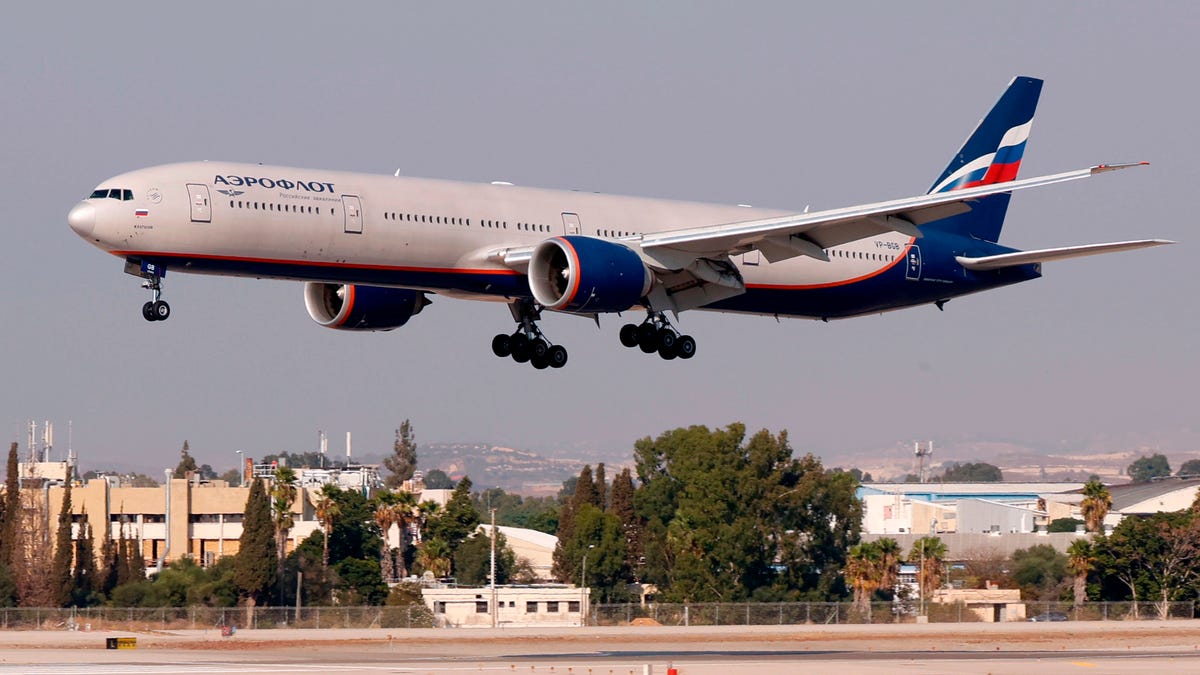Russia's Western Planes Might Become "Very Unsafe" Under International Sanctions

This picture taken on August 3, 2020 shows an Aeroflot-Russian Airlines Boeing 777-3M0 landing at Israel’s Ben Gurion International Airport in Lod, east of Tel Aviv. Photo: Photo by JACK GUEZ / AFP (Getty Images)
Jets are tremendously complicated machines, and without constant maintenance and replacement parts they can quickly become unusable and unsafe. Since March, Boeing and Airbus have been unable and unwilling to supply Russia with parts for their planes and the results could be disastrous.
Russia is increasingly turning to cannibalizing planes for parts, using third-party parts or hiring previously unauthorized servicing companies to keep their Boeings and Airbus jets in the air. All these practices come with an unknown amount of risk to the aircraft. There’s also a risk to the paperwork which details all maintenance done to each plane. Without these detailed records using sanctioned parts and practices, hundred of planes illegally seized by Russia could be rendered worthless, a loss of $10 billion. The parts crunch is already taking some aircraft out of the sky; in May, Russia had a fleet of 876 jets down from 968 in February.
Experts told Wired the first thing to wear down on a plane are, predictably, the tires and the brakes but that’s not all that can break:
Worn-down tires would just be the first indication of decay. Planes are powered by computer systems that require regular maintenance, with some systems programmed to switch off after a number of flight cycles or calendar days and reset. That includes aircraft engines and auxiliary power units, the electricity generator that pumps compressed air through the cabin in flight and powers the firing of the engine when the plane is first turned on. “Some of those parts are life-limited,” says Kingsley Jones. “They literally have to be taken off the aircraft and replaced when they get to a certain age or a certain number of flights.” Despite the stereotype of running old, dilapidated planes into the ground, Russia’s fleet of aircraft compares favorably with those in much of the rest of the world. The average age of a Russian-run plane is 10.5 years, according to the Association of Tour Operators of Russia. The age of the average passenger plane worldwide is 10.3 years, according to management consultancy Oliver Wyman.
“Don’t misunderstand the Russian capability with aeronautical engineering,” says Kingsley Jones. “They are a very capable nation; they have their own aircraft manufacturing industry and are quite capable of maintaining the aircraft they do.” But as Russian airlines run down their supply of official spare parts, they’re going to be forced to adopt alternative measures. In April and May, Russian authorities widened the pool of companies that can service planes operating in the country beyond international norms. “I don’t think it’s that these aircraft are all flying deathtraps,” says Kingsley Jones. “It’s more that there’s an unknown quantity about the whole thing.” Third-party parts, produced by Russian manufacturers, could well be used to replace broken parts. This is something that happens in the rest of the world but is frowned upon by the aircraft leasing companies that provide most of the planes to carriers. (Russia has said it plans to build a parts manufacturing plant in Kazan by 2023 to fill the supply gap.) “If the situation is not really resolved in the next two or three months, Russian aircraft could be grounded totally or forced to fly with unapproved or unauthorized parts,” says Vasigh.
International flights are way down in Russia. Russian jets are leased from European countries which will not hesitate to seize jets flown by airlines in the pariah country. China recently banned such jets from flying in its airspace, according to SimplyFlying, further reducing where these planes can travel in the world. Domestic flights continue apace with 30 more flights inside Russia’s borders than there were two years ago.



